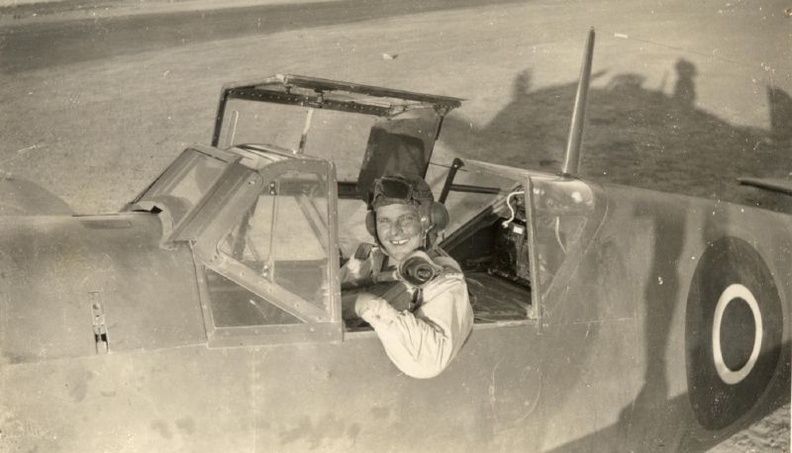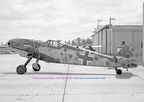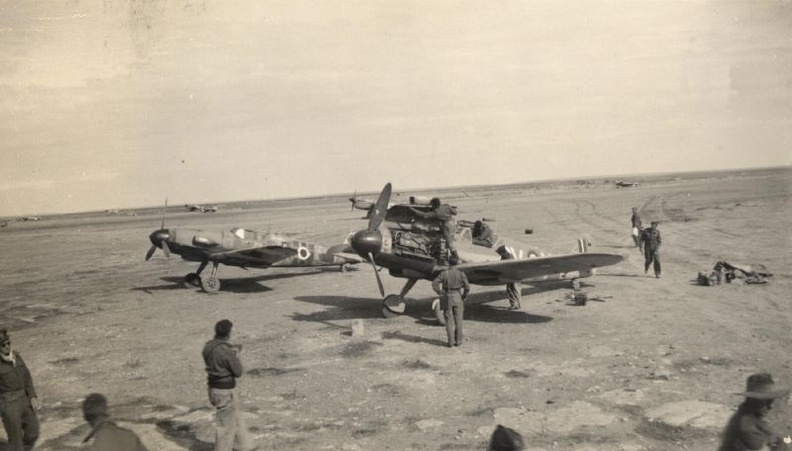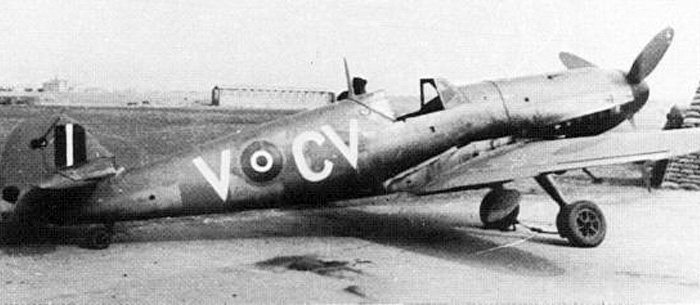| RN288
8478M |
10639
PG + QJ
"Black 6" |
Bf109G-2/Trop
(Modified from
Bf109F-3 during production) |
??/09/1942
Built at Leipzig by Erla Maschinenwerk GmbH,
Started as a Bf109F-3 but converted to Bf109G-2/Trop standard
during construction,
Allocated factory radio code PG + QJ,
13/10/1942 Accepted by Luftwaffe,
21/10/1942 Collected by III./JG77 at München-Riem airfield and
flown to Vicenza, North Italy, and then to Jesi,
22/10/1942 To Foggia and thence to Bari in Italy where, the
radio codes
PG + QJ
were removed and the identity `Black 6' applied,
27/10/1942 Ferried from Bari via Elefsis, Athens to Tobruk East
airfield, Cyrenaica (Libya),
28/10/1942 Flown from Tobruk to El Harun,
02/11/1942 Flown from El Harun to Bir El Abd landing ground,
From this date the aircraft was probably flown by 21 year old
Russian front veteran Heinz Lüdemann of 8/JG77 as his aircraft
`Black 4' had been damaged the previous day,
03/11/1942 Flown from Bir el Abd to Quasaba as the German
retreat following the battle of El Alamein was ordered,
04/11/1942 Lüdemann flew the aircraft from Bir el Abd to
Quotifaiya and took off for an operational sortie. Entry in
Lüdemann's diary:
`During an attack on an English bomber force I was slightly
injured in my head and body by the fighter escort. However, I
managed to get my machine home', (The bomber force comprised
SAAF Bostons escorted by USAAF P-40s),
Aircraft ferried (probably immediately) by an unknown pilot to
Gambut Main airfield (LG 139), SE of Tobruk for repair,
11/11/1942
Abandoned by Luftwaffe,
German records indicate loss of 10639
through enemy action on this date, presumably when Gambut Main
was abandoned to the advancing allies,
13/11/1942 Found abandoned and in a damaged
condition by No. 3 Squadron RAAF, at Gambut Main Airfield
(LG139) airfield near Tobruk,
by Flt Lt (later Wg Cdr) Ken McRae, Engineering Officer of No.3
Squadron Royal Australian Air Force. The aircraft had been
damage to the tailwheel, tail plane, canopy and one propeller
blade, The radio and oxygen equipment were unserviceable and
some instruments missing, Sqn Ldr R H Gibbes, (Commanding
officer of 3 Squadron, RAAF)
estimated that it had flown `no more than 10' hours since
new, The reflector sight and armament had also been removed,
14/11/1942 Using parts from nearby wrecks (including adjacent
Bf109F w/nr 9678) a new tailplane, tailwheel and canopy were
fitted and the hole in the propeller blade plugged. The codes
CV-V - the personal code of Sqn Ldr (later Wg Cdr) R H Gibbes -
were also applied,
Gibbes intended that the aircraft be sent to Australia for
display, and it is reported that he slept beneath the aircraft
when it was first `acquired' to prevent pilfering by other units,
15/11/1942 Gibbes flew the aircraft to Gazala
Satellite II airfield (LG 150) escorted by
Kittyhawks ET899 and AK626, a long taxi run in crosswind
following a guiding Jeep, caused brake fires,
19/11/1942
Gibbes flew CV-V to Martuba No.4 airfield, escorted this time by
Kittyhawks ET899, AK626, ET951 and FL323. His diary records
`the 109 is a hell of a nice kite with terrific performance. On
lowest permissible boost and revs it was clocking 220-230mph',
21/11/1942
Gibbes' diary records `In the afternoon took up 109G for an RAF
film unit. Only up 10 minutes as battery a bit flat and prop
motor wouldn't work`,
29/11/1942
No.209 (Fighter) Group, RAF ordered that the aircraft should be
officially flight tested as one of the first G model 109s to be
captured by the allies,
01/12/1942 Afterwards the cannon and reflector sight were
removed. Excerpt from `3 Squadron at War' records: `a somewhat
mysterious signal was received from HQ Middle East stating that
the captured aircraft had to be flown back there' - for
evaluation,
02/12/1942 Following AOC instructions, Gibbes flew CV-V
to Heliopolis (Cairo) via Martuba, El Adam, Mersa Matruh, Amiyra,
Cairo and flew past some Dakotas `with interesting results', On
take-off from Amiyra the canopy flew off, striking the starboard
wing,
04-05/12/1942 An engineering detachment from No.451 Squadron
RAAF based at St Jean,
Palestine
started work on the aircraft,
07-12/12/1942 Aircraft remained at Heliopolis while No.451
Squadron visited El Daba, Mersa,
12/12/1942 451 Squadron personnel seeking
spares at Matruh and Quasaba,
13-14/12/1942 Work continued,
15/12/1942 Flown by Group Captain Geoffrey Buxton to Lydda,
Palestine where `arrival created a great deal of interest'. The
aircraft was still minus the canopy lost on take-off on
02/12/1942 and the wing was scarred from the impact,
28/12/1942 451 Sqn checked or changed the magneto, changed the
oil and filters, plugs and the rudder. The oil radiator flap
was locked open, as received, because of a malfunctioning
thermostat,
29/12/1942 First test flight after reconditioning (pilot
Group Captain Geoffrey Mungo Buxton) checking speed and rate of
climb,
30/12/1942 Second test flight to check speeds and climb to
25,000 feet,
31/12/1942 Third test flight involving climb to 32,000 feet, 451
Sqn then handed the aircraft over to Lydda Communications
Flight,
17/01/1943 Fourth test flight for partial climbs to 5,000 and
20,000 feet. Before this flight, the propeller was changed,
19/01/1943 Fifth test flight to check the effect of radiator,
flaps etc. on speed,
A sixth test flight was cut short when the canopy again flew
off,
28/01/1943 Further test flight (probably by Ronald Harker of
Rolls-Royce) investigating the engines' ability to run when the
aircraft was inverted,
29/01/1943 Seventh test flight to check climb performance
at full throttle to 35,000 feet,
8th test to check stalling performance,
Feb 43 Ferried to No.107 MU Kasfereet, near Shandur in Egypt
by Wg Cdr Budd for tactical trials,
21/02/1943 Flown by No.107 MU test pilot Flt Lt Richard Martin,
24/02/1943 Flown by John Penny in simulated dogfight against
Spitfire VC EP982 flown by Flt Lt Martin,
??/02/1943 Also flown by WO `Paddy' Donaldson,
1943 Packed and dispatched from North Africa to UK by station
salvage section at RAF Kasfereet,
01/11/1943 RAF serial number RN228 allotted at request of RAE,
26/12/1943
Arrived crated at RAF Collyweston, Lincs from Liverpool Docks
for No.1426 Enemy Aircraft Flight with two other Bf 109s,
27/12/1943
Unpacked but damaged (due to an unsuitable crate) with propeller
and other parts missing, Aircraft assembled using port wing from
a second Bf109G, possibly another former JG 77 Bf109G-2/Trop,
w/nr 10533,
31/01/1944 RAF movement and records formal allocation to No.1426
Flight,
05/02/1944
Replacement propeller arrived from Farnborough,
08/02/1944 Propeller fitted and engine given preliminary ground
run and found to be serviceable, RAF Camouflage and serial
number RN228 applied,
19/02/1944 After delays due to bad weather initial air test
performed by Flt Lt`Lew' Lewendon,
24/02/1944 Comparative trial flight against Hawker Tempest V
JN737 of the Air Fighting Development Unit. Flight curtailed by
problems with the '109 suffering carbon monoxide in the cockpit
affecting the pilot, Lewendon, Flying time 45 minutes, comparing
turns, zoom and rate of roll,
25/28/02/1944 Flown by Fg Off D G M (Doug) Gough in
company with a Hudson for air-to-air photographs,
28/02/1944 Lewendon flew a tactical trial with the 109 against
an AFDU Mustang III, FZ107,
Later that day Gough flew for Ministry of Aircraft Production
photographs,
Other comparative trials were flown against Spitfire IXs BS552
(clipped wings) and JL359 (normal wings and SU carburettor);
FW190 PM679 was also involved,
29/02/1944 Lewendon flew a trial flight against an AFDU Spitfire
XIV (RB141) and made a further photographic sortie accompanied
by a Hudson. On the same day, Gough flew combat trials against a
Corsair in RN228 (30 minutes-see Gough logbook),
01/03/1944 Gough flew against a NAFDU Seafire III in the morning
(25 minutes) and a Corsair in the afternoon (One hour),
02/03/1944 Flown for first time by Fg Off Jack Staples,
Afterwards Lewendon took off for a trial flight against a
Tempest which failed to appear,
07/03/1944 Staples flew a trial against a NAFDU Hellcat,
12/03/1944 Unserviceable because of a faulty ignition harness,
which was removed,
16&21/03/1944 Air tests by Lewendon,
22/03/1944 Fg Off Lewis-Watts flew RN228 for the first time but
bent one prop blade tip on take-off whilst trying to avoid an
Airspeed Oxford, Sgt Dowie started to crop the propeller tips in
order to even up the blades,
23/03/1944 Repairs complete - air tested,
In the afternoon No.1426 Flight began a new tour (its 12th) with
Lewendon flying RN228 accompanied by a Fw190A4, and Bf110C-5,
escorted into Hullavington by two Spitfires from Colerne, then
displayed to a large crowd,
25/03/1944 Lewendon flew RN228 to Bovingdon accompanied by the
Fw190, an Oxford and two Spitfires from Colerne,
27/03/1944 Lewendon flew RN228 on a photographic sortie with a
Boston,
later Lewis-Watts swung the aircraft on take-off, damaging the
starboard wing tip,
a replacement was collected by Oxford from Collyweston the
following day,
30/03/1944 The tour continued to the USAAF base at Chipping
Ongar escorted by a P-38 and a P-47, Lewendon again flying the
109,
30/03/1944 Gough flew from Chipping Ongar for a demonstration
before transiting to Stansted Mountfichet for a further
demonstration,
01/04/1944 Gough flew from Stansted to Great Dunmow (Essex) to
give a further flying demonstration,
04/04/1944 Following rectification of magneto problems, flew
from Great Dunmow to Great Saling. (Pilot - Lewendon),
07/04/1944 Flew to Earl's Colne escorted by P-51s and had
to force-land at Rivenhall requiring a replacement engine,
06/04/1944 Replacement engine, originating from the Middle
East, fitted (-bullet damage had to be repaired first),
22/04/1944 Air tested by Flt Lt Dick Forbes,
05/07/1944 Photographed from a Boston with Lewendon again flying
RN228,
09/08/1944 Left for West Raynham with the Fw190 and Ju88
escorted by three Mosquitos,
10/08/1944 Flew from West Raynham to Little Snoring after mock
combat with three Mosquitos, Burst a tyre whilst taxying in,
11/08/1944 Three sorties flown by Gough, Left Little Snoring
for Massingham for a demonstration flight, then returned to
Collyweston,
09/09/1944 Forbes flew to Thurleigh in company with Fw190 and
Ju88 escorted by Hurricane and Spitfire from Digby and gave a
demonstration flight upon arrival,
17/09/1944 Gough flew from Collyweston to Bradwell Bay via
Northolt in company with Lewendon flying the Fw190 and escorted
by two Spitfires, Ground and air demonstrations given prior to
returning to Collyweston,
18/09/1944 Flew to Chipping Ongar, Instruction given to USAAF
Disarmament School on maintenance and temporary immobilisation
of German aircraft,
RN228 grounded with ignition trouble,
23/09/1944 Following attention Gough flew the aircraft from
Collyweston to Leavesden,
25/09/1944 Demonstration flight by Forbes, Gough then flew RN228
to Chipping Ongar,
16/10/1944 Magneto trouble at Chipping Ongar,
31/10/1944 Gough flew from Chipping Ongar to Collyweston,
21/01/1945 No.1426 Flight disbanded,
27/03/1945 Gough flew RN228 to Tangmere (40 minutes) - it was
transferred to the Enemy Aircraft Flight of the Central Fighter
Establishment,
01/11/1945 Nominally allocated to No.47 MU Sealand,
??/03/1946 Still at Tangmere and inspected there by Air
Historical Branch,
17/04/1946 Finally transferred to No.47 MU Sealand via No.49 MU,
??/05/1946 Packed for Museum storage, A letter from Maintenance
Command dated 20 May 46 on PRO AIR 2/18772 records several areas
of corrosion and deteriorated surface finish,
To RAF Stanmore Park, Middlesex for storage at the German Air
Force Equipment Centre as one of seven AHB aircraft transferred
there from Sealand that month,
17/09/1954 Displayed on Horse Guards Parade, Whitehall during
Battle of Britain Week, in inaccurate brown/green/grey scheme
with duck-egg green undersurfaces. Still carried British oxygen
equipment and English lettering on many instruments,
??/??/1955 To No.15 MU Wroughton, Wilts for continued storage
with other Air Historical Branch airframes,
??/09/1956 To RAF Hendon for the Battle of Britain Open Day
display, and kept in one of the former USAAF blister hangars,
1958 To AHB store at RAF Fulbeck, Lincs; possibly to Wattisham
later that year,
1960 Displayed in one of the hangars at RAF Wattisham,
??04/1962 An attempted restoration to flying condition was begun
by volunteer team led by Wattisham instructor Flt Lt J R Hawke.
The rebuild to airworthy condition was not completed due to the
cost and man-hours involved and concern over the lack of flying
history that could have included over-stressing, and caused
considerable damage to the airframe,
??/09/1962 Following repainting into North European theatre
colours as `White 14' the aircraft was displayed at RAF
Colitishalls' Battle of Britain Day, then returned to Wattisham,
Also displayed at Wethersfield in 1964 and RAF Finningley in
1966,
??/09/1965 Displayed at annual Stowmarket Carnival and Trades
Fair,
??/05/1967 At RAF Henlow by this date for possible use in the
Battle of Britain film still in Wattisham applied `White 14'
colour scheme with E3 canopy ex-Bf109E3 4101 now at Hendon, Not
in the event used for the film,
03/06/1968 Displayed at RAF Henlow Charity Gala,
??/03/1969 Returned to Wattisham ex-Henlow repainted as Yellow
14 of JG53 (Desert Colours),
1971 At RAF Coltishall,
20/09/1972 Flown from Wattisham to Lynham in two Hercules
aircraft for start of restoration by a team led by Flt Lt Russ
Snadden still painted as `Yellow 14',
??/07/1975 Moved to RAF Northolt, RAFM provision of instruments
and recovering of control surfaces at Cardington, other
components obtained from Finnish Air Force Museum (including
radiators and armament items), Swiss Air Force, and European
collectors,
16/02/1976 Allotted
RAF Maintenance serial 8478M,
??/07/1983 Moved to RAF Benson, Oxfordshire,
1987 Engine refitted to airframe, following rebuild by
Rolls-Royce of Bristol,
15/06/1989 Displayed at RAF Benson's 50th Anniversary Open day,
08/07/1990 First engine run,
14/7/1990 Displayed at RAF Benson's Fete,
26/10/1990 Registered as G-USTV to the Imperial War Museum,
Duxford,
17/03/1991 First post-restoration flight from RAF Benson as
"Black 6" ( pilot Gp Capt Reg Hallam),
02 May 91 Officially rolled out, freshly painted at Benson
attended by Wing Cdr Bobby Gibbes and Ken McRae,
09/09/1991 Received CAA permit to fly,
15/09/1991 Public flying display debut at Duxford Air Show,
(Pilot S/Ldr Dave Southwood),
28 Aug 93 Temporarily grounded when starter dog split at Duxford,
followed later by fuel leakage problems and returned to the air
in September 1994, The three year flying agreement with the MoD
extended for one year due to loss of season's flying, and
subsequently extended in 1995 for a further two years to 1997,
12/10/1997 Damaged on last planned flight before transfer to RAF
Museum in crash-landing following a display at Duxford’s’ Autumn
Air Show. (Pilot, Air Chief Marshal Sir John Allison, unhurt),
The aircraft landed wheels down in a field of stubble, ran
through into a ploughed area, sank into the soft earth and
turned over, buckling the rear fuselage, crushing the fin and
rudder and damaging the spinner, propeller, upper fuselage and
one wing tip. This was the aircraft’s last flight and over three
and a half seasons of display it had amassed 96 flying hours,
26/10/1997 Following recovery from the crash site, wings and
tailplane removed and the fuselage turned back over using a
crane
03/11/1997 Moved to workshops at Duxford to await decision on
its future,
1998 Decision announced that the aircraft would be restored to
static display condition under a contract managed by the IWM
Duxford and then placed on display at the RAF Museum Hendon
following the restoration,
The contract was won by the volunteer team which originally
restored the aircraft. Work was due to begin early in 1999 with
completion expected within two years. The group was led again by
Russ Snadden who set up Messerschmitt Restorations Ltd, to
undertake the work. The fuselage was restored by Charleston
Aviation, Essex and replacement Bf109 fin fitted. The
restoration left the aircraft around 70% original. The damaged
rear fuselage skin has been displayed at the Shoreham Aircraft
Museum, Kent since 2006,
24/11/1998 Civilian registration G-USTV cancelled,
10/03/2002 Delivered by road to RAFM Hendon (wings the previous
day) and assembled for display in Bomber Command Hall. Photos on
arrival,
15/03/2002 Formally struck off RAF charge by ES (Air) Allotment
d024/02 following its 1998 gifting to the RAF Museum,
17/06/2003 Moved into new Milestones of Flight building at RAFM
Hendon,
??/01/2012 Moved to Bomber Hall at RAFM Hendon,
16/11/2018 Arrived at RAF Cosford ex Hendon,
Preserved with the RAF Museum.
 |







